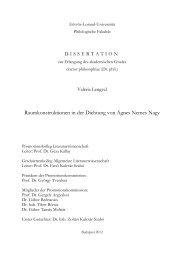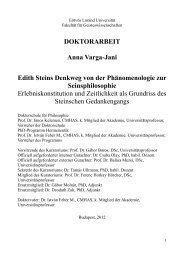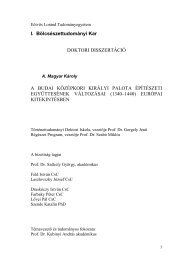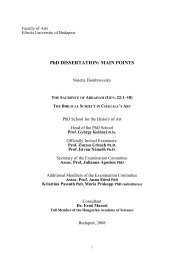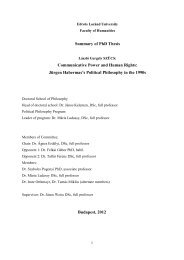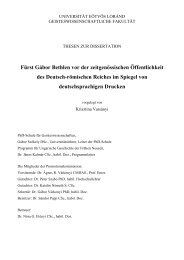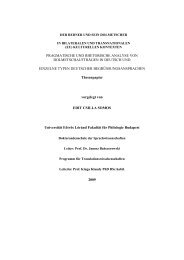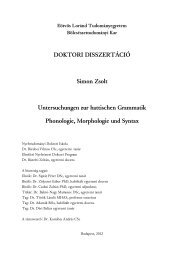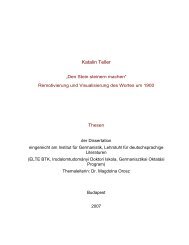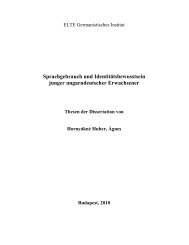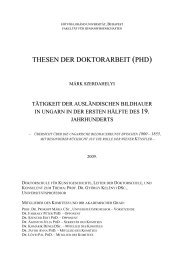Zsuzsanna Kutasi - ELTE BTK disszertációk
Zsuzsanna Kutasi - ELTE BTK disszertációk
Zsuzsanna Kutasi - ELTE BTK disszertációk
Create successful ePaper yourself
Turn your PDF publications into a flip-book with our unique Google optimized e-Paper software.
I have collated four different collections concerning the names of the horse’s body<br />
parts. Two groups from these words are in the Syrian and Saudi dialects, and the other two<br />
froms Egyptian and Iraqi agricultural school-books together with a modern expressions for<br />
them. I have compared them with the Classical Arabic terminology and found that among the<br />
dialectical words, some Classical Arabic expressions are preserved, but with meanings<br />
different from those in the Middle Ages. Thus zawr in the Saudi dialect means the chest,<br />
instead of the place of the first six ribs on the horse’s side, (as in Classical Arabic Language)<br />
and in the Egyptian dialect means the throat like in the case of a human. According to the<br />
explanation of the al-Mu‘ağam al-wasīÔ, the zawr is the meeting point of the first ribs at the<br />
bottom of the chest, which means that it should be at the bottom of the chest and on the place<br />
behind the elbows too. It depends on the author’s interpretation what he means by the term.<br />
The best way for us to find a correct meaning of a word concerning one of the horse’s body<br />
parts, if we know the author’s living place. It is impossible to explain a Saudi horse’s<br />
description with the horse terminology in Iraqi or in Egyptian dialects. For example sāq (tibia)<br />
means in Saudi dialect cannon, and on the place of the CA sāq is the fahid /afhād (thigh in<br />
CA). Sāq means the cannon at the human’s body parts, therefore I think that the Saudi<br />
Bedouins named the horse’s body parts like they did it at the case of the human, but they did<br />
not name it in anatomically meaning.<br />
Then the foremost cause of the difference among the interpretations referring to the<br />
horse’s body parts is the false correspondences to the human’s parts. As we know, in the place<br />
of the horse’s hocks are our heels, and our feet are similar to the horse’s cannons, our fingers<br />
and our nails correspond to the horse’s pasterns and its hoofs. In the Saudi dialect, the basis of<br />
comparison is the function and not the anatomy. We can see an excellent example of this<br />
among the names of the camel’s body parts 29 , where the names are “slipped up” on the hind<br />
legs because the tibia’s name is lacking on it. Its name is in the place of the cannon. Likewise,<br />
on the fore legs the upper arm is in the place of the forearm and the forearm is in the place of<br />
the cannon. (As the anatomical upper arm does not exists.) Therefore the Classical Arabic<br />
name of the cannon (waÛīf) is lacking. The book on the camel is replete with Classical Arabic<br />
verses which were written about the camel’s body parts as metaphors. Since there are many<br />
differences among the Classical Arabic interpretations and the modern Arabic descriptions<br />
concerning the camel’s body parts, thus the explanations in the verses are uncertain too.<br />
29 Al-ibil al-‘arabiyya al-aÒīla. Dār Ğarrūs Press, Libanon, 1990. pp. 68. and 83.<br />
12



